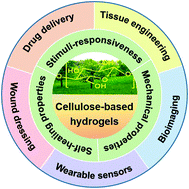Multifunctional cellulose-based hydrogels for biomedical applications
Abstract
In recent decades, cellulose has been extensively investigated due to its favourable properties, such as hydrophilicity, low-cost, biodegradability, biocompatibility, and non-toxicity, which makes it a good feedstock for the synthesis of biocompatible hydrogels. The plentiful hydrophilic functional groups (such as hydroxyl, carboxyl, and aldehyde groups) in the backbone of cellulose and its derivatives can be used to prepare hydrogels easily with fascinating structures and properties, leading to burgeoning research interest in biomedical applications. This review focuses on state-of-the-art progress in cellulose-based hydrogels, which covers from their preparation methods (including chemical methods and physical methods) and physicochemical properties (such as stimuli-responsive properties, mechanical properties, and self-healing properties) to their biomedical applications, including drug delivery, tissue engineering, wound dressing, bioimaging, wearable sensors and so on. Moreover, the current challenges and future prospects for cellulose-based hydrogels in regard to their biomedical applications are also discussed at the end.

- This article is part of the themed collection: Hydrogel properties and applications


 Please wait while we load your content...
Please wait while we load your content...